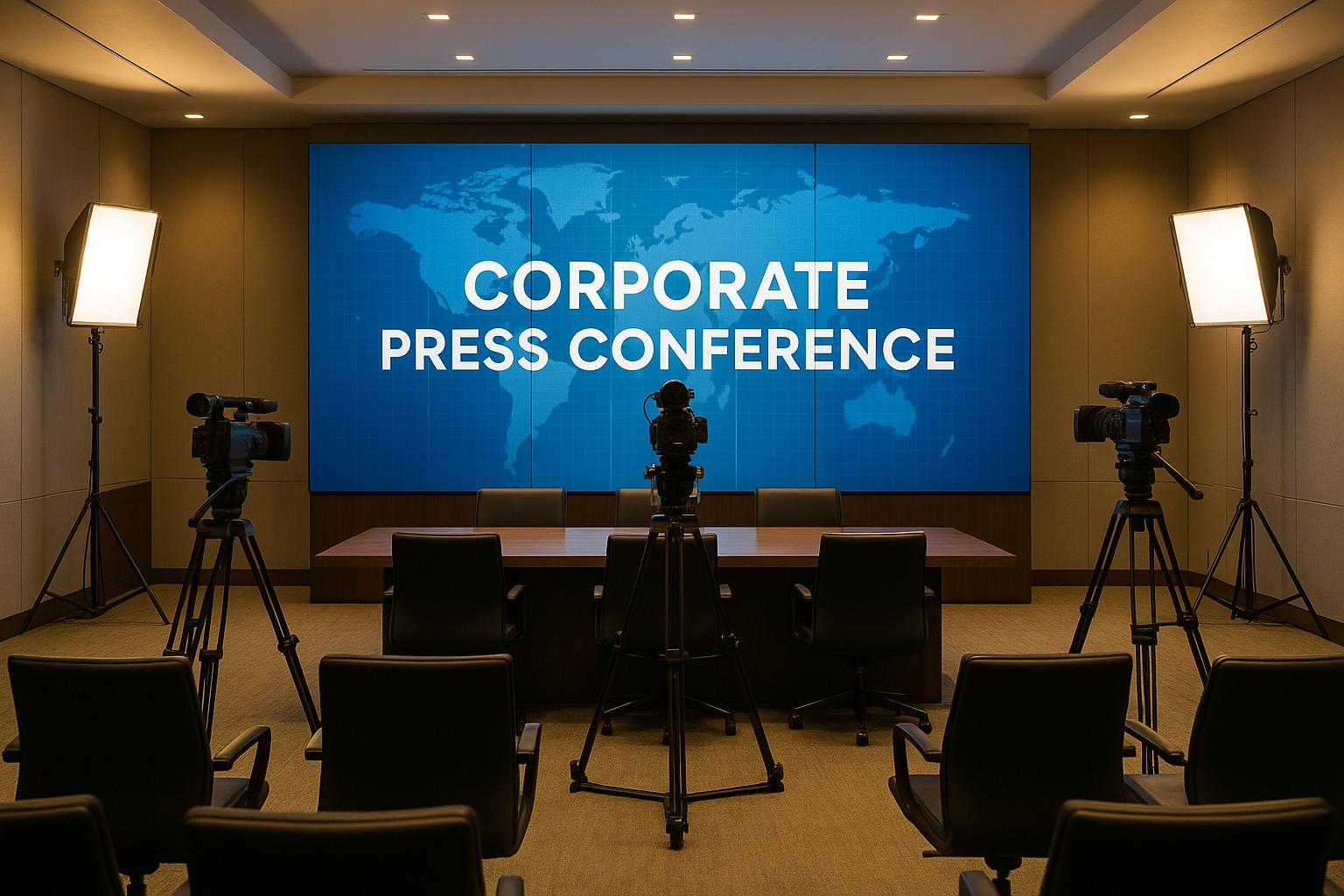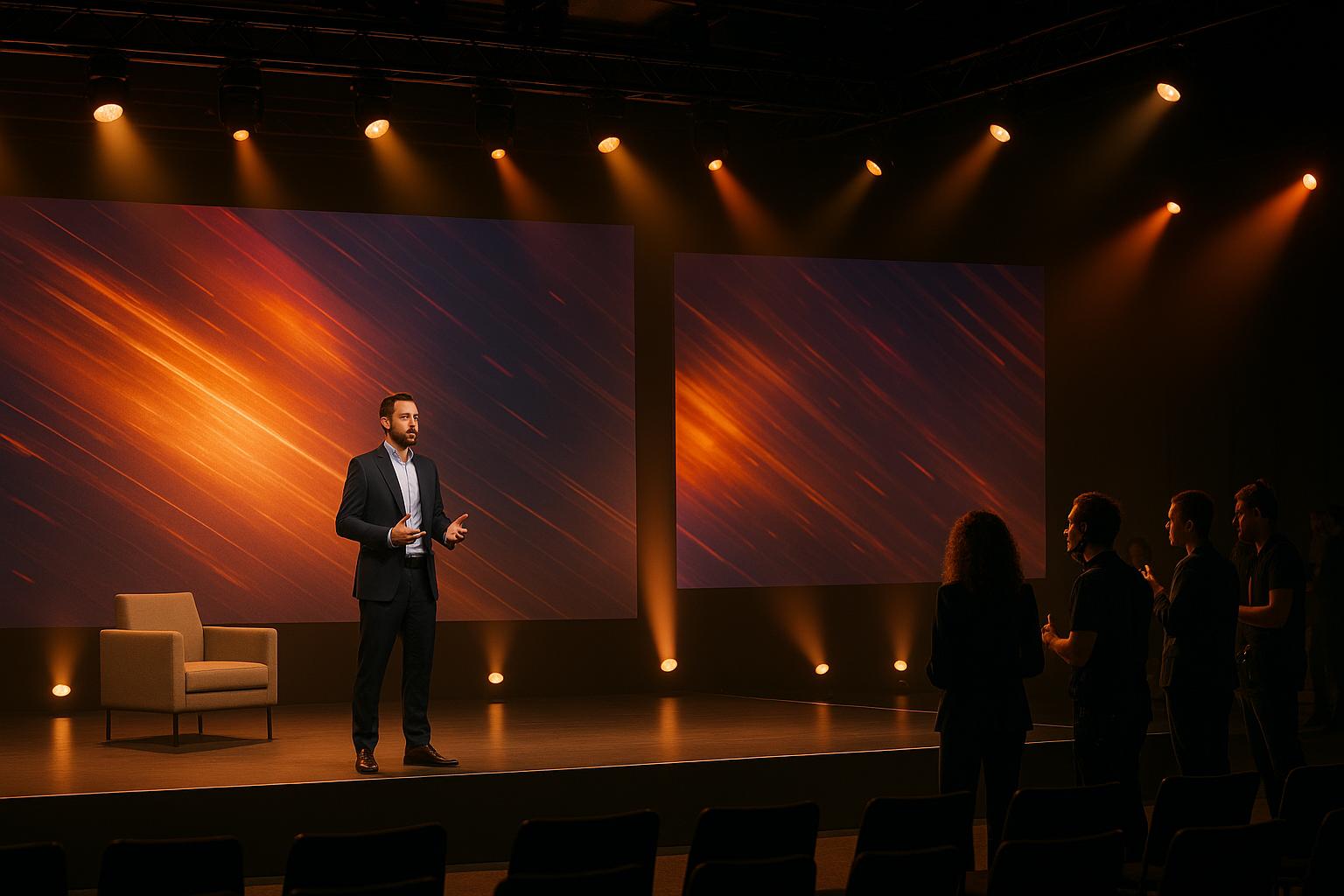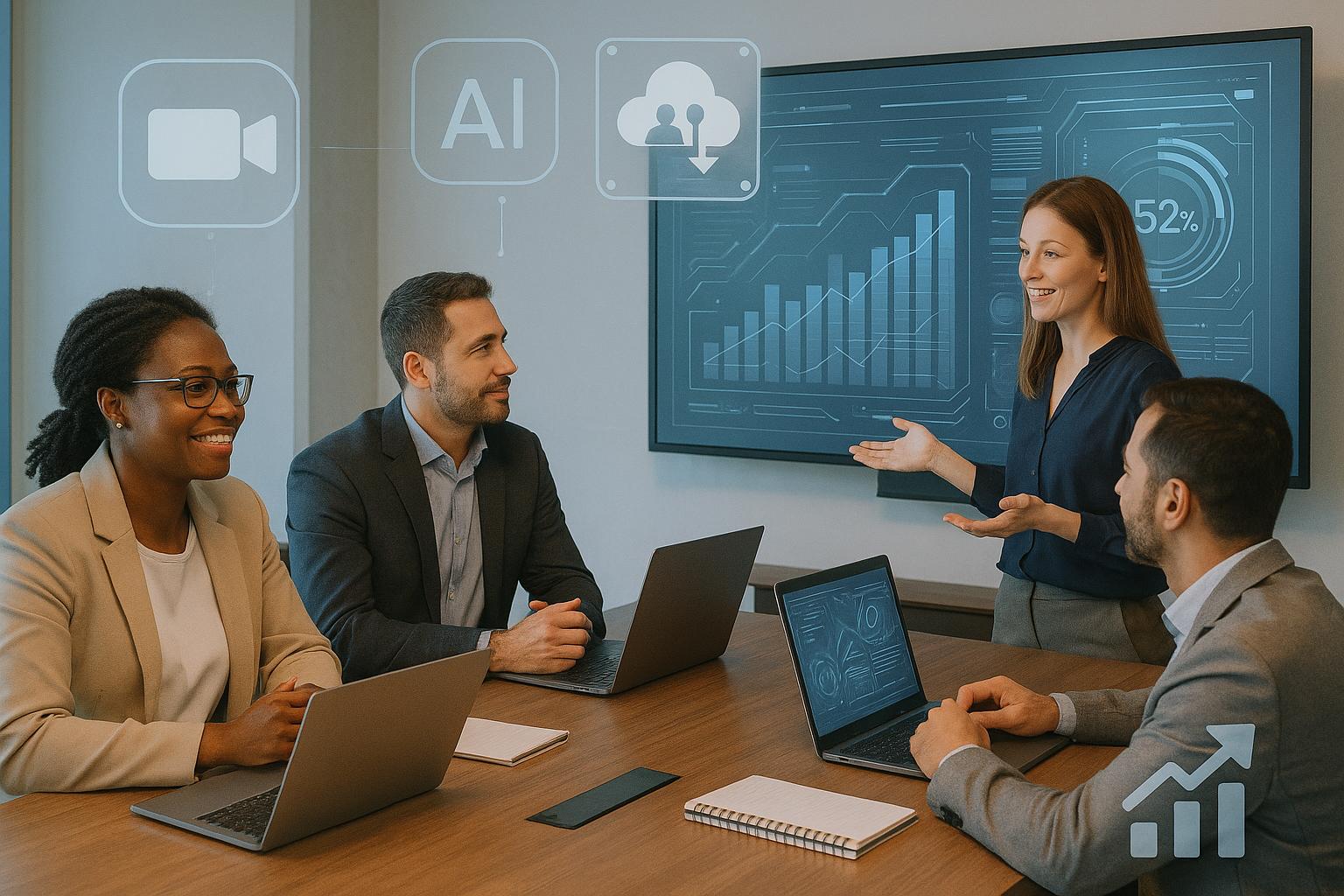Ultimate Guide to Scenic Fabrication for Events

Chief Executive Officer

Scenic fabrication transforms event spaces into immersive environments tailored to specific goals, creating memorable experiences for attendees. It combines design, craftsmanship, and technology to build custom elements like backdrops, stage sets, and interactive installations. The process involves:
- Design Planning: Using CAD software and 3D renderings to visualize concepts and align with budgets.
- Material Selection: Choosing materials like wood, foam, and metals for durability, aesthetics, and function.
- Fabrication Techniques: Combining carpentry, metalwork, and artistic finishes, often leveraging CNC machining and 3D printing.
- Installation: Ensuring precise setup, safety compliance, and integration with AV systems.
- Post-Event Management: Properly storing and reusing scenic assets to maximize ROI and reduce waste.
Modern tools like 3D printing and CNC machining enhance precision and efficiency, while sustainable practices, such as using recycled materials, address growing environmental concerns. Scenic fabrication is vital for creating impactful events that resonate with audiences and extend their reach through social sharing.
An Introduction to Scenic Design
The Scenic Fabrication Process: From Concept to Installation
Turning creative ideas into real-world scenic installations is a detailed process that requires teamwork, precision, and a clear vision. Designers, fabricators, and event production teams must collaborate at every step to ensure the final product meets both aesthetic and functional goals. Understanding how this process works can help event planners make smarter choices and set clear expectations for their projects.
Concept Development and Design Planning
Every successful scenic project starts with a solid plan. During initial meetings, teams define the vision, goals, audience, budget, and technical needs for the installation. This phase lays the groundwork for everything that follows.
To bring ideas to life, designers use tools like CAD software and 3D renderings. These visualizations allow everyone involved to see exactly how the final design will look and function in the venue. This not only reduces guesswork but also helps avoid costly revisions later in the process.
Budget planning happens alongside design development. Teams often need to get creative to balance ambitious ideas with financial constraints. This could mean choosing alternative materials, adjusting the scale of the design, or finding efficient fabrication methods that still deliver on impact.
Once the design is finalized, technical drawings and specifications are prepared. These documents are the project’s blueprint, detailing measurements, materials, assembly instructions, and safety considerations. With everything clearly outlined, the project moves seamlessly into the fabrication stage.
Fabrication Methods and Material Selection
The fabrication phase is where designs take physical form, combining craftsmanship with technical expertise. Carpentry is a key component, creating the structural foundation for many scenic elements. Carpenters use both traditional tools and CNC machines to achieve precise cuts and intricate shapes.
Metalwork plays an important role in adding strength and versatility to designs. From simple frames to complex sculptures, metal fabricators rely on materials like steel and aluminum for their durability and lightweight properties. Occasionally, metals like brass or copper are chosen for their visual appeal, adding a touch of elegance to the design.
Artistic techniques bring the structures to life. Scenic artists use painting, texturing, digital printing, and specialty finishes to create eye-catching visuals. Borrowing from film and theater techniques, they can mimic natural materials like stone or wood at a fraction of the weight and cost.
Material selection is a balancing act between aesthetics, durability, and budget. Lightweight materials like foam core or honeycomb panels are often used to simplify transportation and installation. However, in high-traffic areas, sturdier options like plywood or metal substrates may be necessary.
Modular construction is becoming increasingly popular. By breaking large installations into smaller, manageable sections, this approach makes transportation and assembly easier while offering flexibility for future use or reconfiguration. Regular inspections throughout fabrication ensure that everything meets specifications and safety standards, avoiding delays or issues during installation.
On-Site Installation and Setup
The installation phase is where all the planning and fabrication come together. It starts with careful transportation logistics. Scenic elements must be packed securely to prevent damage, and large pieces may require special vehicles or permits. Delivery schedules are tightly coordinated so components arrive in the correct order for assembly.
Before installation begins, the venue is surveyed to confirm that ceiling heights, load capacities, and access points align with the design plans. Any discrepancies are addressed immediately to avoid delays.
Assembly requires precise timing and clear communication. Teams follow a step-by-step process to ensure structural safety and efficiency. For larger projects, multiple crews often work simultaneously, requiring careful coordination to avoid overlap or confusion.
Scenic elements must also integrate seamlessly with lighting, projection, and audio systems. Cable management and equipment access are planned during the design phase to ensure everything works together smoothly. At Corporate Optics, for example, scenic designs are created with AV integration in mind from the start, resulting in immersive and cohesive event experiences.
Safety is a top priority during installation. Regular briefings, proper protective gear, and certified riggers for overhead work ensure that everyone on-site remains safe.
The final steps include inspections, adjustments, and testing. Teams check structural connections, finish quality, and the integration of scenic elements with other event components. Any last-minute fixes or touch-ups are completed before the venue is handed over to the event organizers.
Installation timelines vary depending on the complexity and size of the project. Simple setups might take just a few hours, while elaborate designs with multiple elements could require several days. Experienced teams build extra time into their schedules to handle unexpected challenges and ensure everything is ready well before the event begins. After the installation, maintaining and managing these scenic elements becomes key to ensuring their longevity and success in future events.
Materials and Technologies in Scenic Fabrication
The tools and materials used in scenic fabrication have come a long way, enabling production teams to turn creative ideas into impressive installations. These choices need to balance artistic vision, functionality, and budget constraints. Once the design and installation processes are in place, picking the right materials becomes a critical step in bringing these concepts to life. Let’s dive into the materials and technologies that make it all possible.
Common Materials for Scenic Fabrication
When it comes to building the foundation of scenic designs, wood and composites are key players. Softwoods like pine and fir are lightweight and budget-friendly, making them ideal for framing. On the other hand, hardwoods such as oak and maple provide durability and a polished look for areas that need to stand up to wear and tear. Plywood is another go-to material, offering sturdy, moisture-resistant sheets that are perfect for outdoor events.
For smooth, paint-ready surfaces, MDF (Medium-Density Fiberboard) is a popular choice. It’s stable and easy to work with, though it’s not suitable for load-bearing structures. Similarly, fiberboard is often used for creating sleek surfaces on custom furniture, wall panels, and stages.
Fabrics bring texture, affordability, and portability to the table. Muslin, a lightweight cotton fabric, is perfect for backdrops and curtains, as it absorbs paint and dyes beautifully. For more demanding uses, canvas offers the durability needed for painted backdrops, floor cloths, and scenery coverings.
Foam materials are increasingly popular for their versatility and lightweight nature. EPS foam, in particular, is widely used in CNC fabrication. Composed mostly of air, it’s recyclable, absorbs minimal moisture, and provides excellent cushioning.
Composites and acrylics also play a significant role, offering durability and compatibility with CNC cutting. The material choice often hinges on factors like weight, fire safety regulations, and how long the installation needs to last.
Technology Advances in Scenic Design
Advancements in technology have revolutionized scenic design. Digital tools like AutoCAD, SketchUp, and Maya have replaced traditional hand-drawn sketches, allowing designers to visualize their ideas in 3D before production even begins.
CNC machining has transformed the fabrication process by delivering precision and efficiency. These machines can handle a variety of materials, including wood, composites, acrylic, and foams like polyurethane and EPS, making them indispensable for creating intricate designs.
Another game-changer is 3D printing, which has opened up new possibilities for scenic fabrication. The market for 3D printing was valued at $20.37 billion in 2023 and is expected to grow significantly in the coming years. Large-format 3D printers can produce massive installations faster and at a lower cost. The range of materials has also expanded, now including resins, nylons, PLA/PETG, and even fire-retardant or elastic options.
Many production teams take a hybrid approach, combining modern methods like 3D printing and CNC machining with traditional craftsmanship. This allows for the precision of new technologies while maintaining the finish and detail that only hands-on techniques can provide.
Material and Technique Comparison
Choosing the right materials and methods depends on several factors, including cost, transportation, installation time, and reusability. Traditional techniques often require more time and labor, while CNC machining and 3D printing offer faster production, less waste, and higher precision. Materials like hardwood and canvas are great for repeated use, while CNC-cut composites and some 3D-printed materials can provide the durability needed for demanding applications.
Efficiency is another key advantage of modern techniques. CNC machines operate continuously, and 3D printing allows for rapid prototyping and quick turnarounds, making them ideal for projects with tight deadlines.
Environmental impact is becoming an increasingly important consideration. Sustainable materials like reclaimed wood and recycled plastics are gaining traction. EPS foam, for example, is not only lightweight but also recyclable, making it a responsible choice for temporary setups.
Modern digital workflows streamline the entire process, from CAD design to CAM fabrication, reducing errors and shortening the time between design approval and installation.
For event planners working with companies like Corporate Optics, understanding the available materials and technologies can lead to more productive discussions about project possibilities. The key is finding the right combination of materials and techniques to meet the unique demands of each event, whether it’s budget constraints, venue requirements, or setup logistics.
In practice, many successful projects blend traditional craftsmanship with modern technology. CNC machining might be used for structural elements, 3D printing for intricate decorative pieces, and traditional methods for finishing touches. This balanced approach often delivers the best results in terms of cost, quality, and efficiency, setting the standard for custom scenic fabrication.
sbb-itb-ae35a94
Best Practices for Custom Scenic Fabrication
When it comes to custom scenic fabrication, success hinges on careful planning, seamless coordination, and flawless execution. By following these best practices, you can ensure your event's scenic elements not only look stunning but also function effectively to meet your goals.
Designing for Event Goals and Audience
Scenic elements should go beyond just looking good - they need to align with your event's purpose and audience. For instance, the design approach for a corporate leadership conference will differ from that of a product launch or an award ceremony. A casual, modern setup might suit a tech startup but feel completely out of place at a formal shareholder meeting.
To maintain brand consistency, every design choice - colors, materials, and layouts - should reflect the company’s identity. Also, consider how scenic pieces will appear under stage lighting. For instance, matte finishes often photograph better than glossy ones, and certain fabrics can create distracting shadows or reflections.
Audience experience should also drive your decisions. Think about how people will move through the space and how scenic elements will look from different angles. A piece that looks great from the front row might block the view for those in the back. Accessibility is equally important - designs must ensure wheelchair users and individuals with mobility challenges can comfortably navigate the space.
The venue itself plays a big role in shaping your design. High ceilings allow for dramatic hanging elements, while low ceilings might require a more horizontal approach. Load-bearing capabilities and existing lighting setups will also influence what can be installed and where.
Once your design goals are clear, the next step is integrating scenic elements with AV systems for a flawless event experience.
Coordinating Scenic Elements with AV Systems
Early collaboration between scenic and AV teams is a must to avoid costly last-minute adjustments. Scenic elements should include features like built-in cable routes and access panels to simplify AV setup and keep installations clean and safe.
Lighting is a critical consideration. Different materials - fabrics, paints, and finishes - react in unique ways under various lighting conditions. For example, glossy surfaces can cause glare, while textured materials might disrupt projections. If you’re using LED strips or projection mapping, ensure the surfaces are compatible with these technologies.
Speaker placement often gets overlooked during scenic design, which can lead to compromises that hurt both sound quality and aesthetics. Scenic elements can actually enhance audio if designed with sound distribution in mind, such as using curved surfaces to redirect sound or incorporating acoustic panels that double as decorative features.
Video displays, like LED walls or projection screens, require special attention. These systems need precise mounting, proper ventilation, and structural support. Their weight and power requirements must be factored into the design from the start to avoid issues during installation.
Companies like Corporate Optics excel in this area because they handle both scenic fabrication and AV production. By integrating these services, they eliminate the communication gaps that can arise when different vendors work independently.
After syncing scenic and technical elements, the focus shifts to safety, compliance, and environmentally conscious practices.
Safety, Compliance, and Environmental Considerations
Safety and compliance are non-negotiable in scenic fabrication. Fire safety regulations vary by venue and jurisdiction, so using flame-retardant materials and securing proper certifications is essential. For example, fabrics often need to meet NFPA 701 standards, and foam materials may require special treatments.
Planning for compliance during the design phase can save time and prevent delays. Structural calculations should account for dynamic loads like wind, vibration, and contact with attendees. Suspended elements need safety cables as backups, and many venues require structural engineering stamps for heavier or taller installations.
Electrical safety is another critical area, especially for scenic elements with lighting, motors, or interactive features. Ground-fault circuit interrupters (GFCIs) are typically required, along with proper grounding and cable protection to prevent tripping hazards. Emergency shutoffs are also a must for quick responses to any issues.
On the environmental front, sustainable practices are becoming the norm. Options like reclaimed wood, recycled plastics, and low-VOC paints are both eco-friendly and effective. Modular designs allow scenic elements to be reused for future events, reducing waste. Sourcing materials locally can cut transportation costs and environmental impact while supporting nearby businesses.
Designing for waste reduction starts early. Mechanical fasteners make disassembly easier than adhesives, and standardized components can be repurposed for different events. Material recovery programs can redirect reusable materials to other projects instead of sending them to landfills.
Indoor air quality is another factor to consider. Using low-emission materials and ensuring proper ventilation during construction protects both fabricators and event attendees. Some venues even require off-gassing periods before events, so plan your timeline accordingly.
Balancing creativity with safety and sustainability is key to successful scenic fabrication. Whether you’re working with a specialized production company or managing the process internally, these best practices ensure your designs are not only visually impactful but also safe, functional, and environmentally responsible.
Managing Scenic Assets After the Event
Once your event wraps up, the job isn't over. Properly managing and maintaining scenic assets is essential to protect your investment and prepare for future use. With a smart approach, what might seem like a one-time expense can become a resource for years to come.
Maintaining Scenic Elements During the Event
Events are unpredictable, and unexpected challenges can arise at any moment. Having the right team on-site can mean the difference between a small hiccup and a major issue.
Experienced managers overseeing the event in real-time are key to addressing problems quickly. The level of attention needed depends on the event itself. A one-day conference may only require occasional check-ins, while multi-day events often demand constant monitoring to ensure everything runs smoothly.
Breakdown, Storage, and Future Use
What happens after the event is just as important as the event itself. How scenic elements are disassembled and stored can significantly impact their usability for future projects.
Careful breakdown and storage practices extend the life of scenic elements and help cut costs down the line. For example, modular and re-skinnable designs are highly versatile, making it easy to adapt or rebrand them for different events.
When it comes to storage, the right solution depends on the type of material and how long you plan to keep it. Sensitive materials like fabric or wood benefit from climate-controlled warehouses, while sturdier materials like metal and plastic can often be stored in standard facilities. Some organizations even set up shared storage depots, which make it easier to preserve and access scenic assets for future use.
Planning for easy disassembly from the very start is another way to simplify future reuse. Additionally, collaborating with other productions can maximize the value of stored assets, ensuring they continue to provide benefits over time. By strategically storing and reusing scenic elements, you can stretch your event's impact and make the most of your budget.
Conclusion: Main Points for Event Scenic Fabrication
Scenic fabrication transforms event spaces into immersive environments that leave a lasting impression on audiences while reinforcing the event's message. This process involves a well-organized approach, starting with concept development and ending with post-event asset management. Each phase relies on the collaboration of creative, technical, and logistical teams to ensure success.
Early planning is essential to align scenic designs with the event's goals and the expectations of the audience. This stage lays the groundwork for decisions about materials, fabrication techniques, and installation logistics.
Technology has become a cornerstone of scenic design, blending traditional elements with modern innovations. Features like advanced lighting, video displays, and automation create dynamic, interactive experiences that elevate the overall impact of events.
Expert craftsmanship and seamless teamwork are key to achieving both visual excellence and cost efficiency. Companies like Corporate Optics, known for their expertise in technical event production and scenic fabrication, have successfully executed major corporate and sporting events, delivering both aesthetic appeal and operational precision.
Customization is another critical element, as the scenic design should reflect the event's unique goals, audience, and brand identity. Tailored elements not only enhance the attendee experience but also generate buzz through social sharing, amplifying the event's reach and impact.
Emerging technologies, such as photorealistic 3D renderings, CNC machining, and 3D printing, have revolutionized the design and production process. These tools streamline client approvals, reduce delays, and bring creative visions to life with precision.
Post-event asset management is equally important. Proper breakdown, storage, and evaluation of scenic elements extend their usability, maximizing the return on investment while supporting sustainability efforts. By planning for reuse during the design phase, organizations can stretch their budgets further and reduce waste.
In a world dominated by digital experiences, scenic fabrication offers a tangible, memorable touchpoint for attendees. When executed with care and creativity, it leaves an enduring impression that continues to resonate long after the event concludes.
FAQs
How can event planners ensure scenic designs meet both visual and practical needs during the planning process?
To create scenic designs that are both visually appealing and practical, event planners should start collaborating with design and technical teams as early as possible. This early partnership helps develop custom solutions that not only match the event's theme but also meet important criteria like safety, durability, and logistics.
By prioritizing scenic elements tailored to boost audience engagement and align with the event's goals, planners can deliver immersive settings that are as functional as they are stunning.
How can scenic elements and AV systems be effectively integrated to create a seamless event experience?
To ensure a smooth and engaging event, it's crucial to align scenic elements and AV systems right from the beginning. This means planning the design and placement of scenic features with AV technology in mind so that they work together both visually and practically. For instance, avoid positioning scenic structures where they could block projectors, screens, or other essential AV equipment.
Leveraging integrated control systems can make a big difference by synchronizing scenic and AV components seamlessly. This allows lighting, visuals, and set pieces to flow together, creating a cohesive and immersive atmosphere. Open and consistent communication between scenic designers, AV technicians, and event planners is essential throughout the process to deliver a polished and unified event experience.
How can scenic fabrication projects be made more sustainable to minimize waste and environmental impact?
To create scenic designs with a lighter environmental footprint, consider starting with environmentally conscious materials. For instance, opt for FSC-certified wood, low-VOC paints, and substrates that can be recycled. Incorporating materials that are both reusable and durable can significantly cut down on waste while extending the life of your scenic elements.
Another smart approach is reusing components across multiple events. Recycling materials like steel, foam, and plastics further reduces waste and resource use. Efficient on-site coordination plays a key role here - it ensures materials are either reused or recycled effectively, helping to conserve resources and limit unnecessary waste.
Related posts









